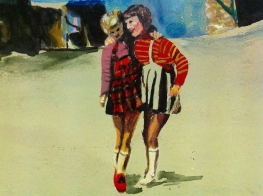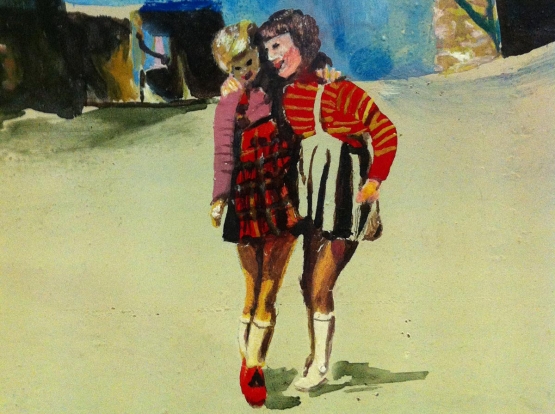ARTIST'S LIST
Ana Bezelga, Ana Pérez-Quiroga, Ana Pérez-Quiroga e Patrícia Guerreiro, Ana Pissarra, Carla Cruz, Catarina Saraiva, Célia Domingues, Cristina Regadas, Elisabetta di Sopra, Hong Yane Wang, Itziar Okariz, Joana Bastos, Lilibeth Cuenca Rasmussen, Maimuna Adam, Mare Tralla, Maria Kheirkhah, Maria Lusitano, Mónica de Miranda, Nilbar Güres, Nisrine Boukhari, Oreet Ashery, Patrícia Guerreiro, paula roush & Maria Lusitano, Pushpamala N, Rachel Korman, Razan Akramaw, Rita GT, Roberta Lima, Sükran Moral, Susana Mendes Silva, Tejal Shah, Zanele Muholi.
hetero q.b.
This international programme of events showcases a group of video works, made by women, which deal with themes ranging from feminism, to lesbianism and transgender. The selection spans countries and realities that are seen as ‘peripheral’ in relation to classic Euro-American feminist discourses and practices – normally regarded as more progressive defenders of the equality of women and of gender.
They are societies in which, in recent decades, historic, cultural, social, political and natural tensions surrounding gender have been played out according to different rules, challenging the very history of the feminist movement.
This season also reveals some of the most significant debates in relation to issues of feminisms or post-feminism, as well as the entire range of queer diversity, from lesbianism, bisexuality, transexuality or transgender, which has been fundamental in clarifying and constructing a new culture and mentality with respect to these realities.
One such debate has been instigated by Judith Butler, whose theorising of these issues from a historical perspective has recently led to an advocacy of a rapprochement of the feminist and transgender movements around a shared set of values, countering a latent conflict between the many factions of sexual identity, in favour of a society which reconfigures the distinctions between internal and external life, rejecting the pathologising of cross-gender identification. For Butler, the terms used to designate gender are historical categories and undergo a continual process of reshaping, leaving room for other possible ways of understanding them, since ‘sex’ and ‘anatomy’ are also subject to cultural regulations and norms. ‘Masculine’ and ‘feminine’ are constantly undergoing transformations, each one of those terms having social histories which change radically according to geopolitical borders and cultural obligations.
Another debate has opposed the hegemony of Euro-American feminist discourse in black, Indian, Chinese and Arab cultures and countries, denouncing the dichotomies inherent to ‘white’ feminist discourse as a form of perpetuating the structural power relationships of the capitalist system and asserting a Western approach of superiority over the ‘other’. This is an area in which feminist discourse is being rethought, enabling new forms of activism and theory. Specific studies and works on black feminism, or feminism within Islam have been the precursors to a new heterogeneous and decentralising approach to classic feminist discourse. This new approach has much in common with the reality of southern European countries, by encouraging a convergence of debate and practice in spheres of action that contemplate facets such as the intimate and the biographical, popular culture and customs, rather than philosophical and theoretical discussion.
The aim of this season of events is not to construct a propagandistic discourse on gender issues. It is however informed by the belief that the heterosexual framework of contemporary society plays a normalising and regulating role for patriarchal authority, and that its implementation permits the existence of significant areas of inequality. This is indeed demonstrated by the multiplicity of artistic approaches which have developed in diverse social spheres over recent decades, using various forms of expression to confront, condemn, reveal or simply explore the complexity of gender and the way it is experienced.
Gender theory has been debated and questioned in numerous scientific and intellectual spheres, however it has also entered the realm of public debate, combining the examination and condemnation of the new models of the experience of sexuality and the creation of a corresponding legal and political framework.
The theme is still a taboo whose specifics have been little examined in various societies, for various reasons. However a recent collection of articles on the subject, published in the magazine Le Magazine Littéraire posed a pertinent question, asking if we ‘should be scared of gender or, on the contrary, should take advantage of the way that it destabilises our normal ways of thinking in order to transform/better our society.’ Gender is also a doctrine under construction, whose boundaries of debate and investigation have in recent years expanded exponentially, just as it has intervened divisively in the moral, ethical and social organisation of contemporary societies, which alone justifies our attention to the theme.
The programme of events we now present aims to contribute to an understanding of the complexity of gender and the feminine, through artistic and heterogeneous thought conducive to an awareness of equality and tolerance.
Emília Tavares
Curator
Dear Emília
I am still in the grip of the ‘panopticon’ after our visit to the exhibition at the Hospital Miguel Bombarda Museum. The area dedicated to Valentim de Barros, the dancer and artist who lived in the Secure Pavilion for more than 40 years, both disturbed and inspired me, in equal measure, in its revelation of the art and the suffering of a life regulated by the prison hospital. The exhibition included two black and white photographs of Valentim, enacting two scenes for the camera that somehow define what his everyday life must have been like in the cell, that tiny space of just a few square metres, which we were also able to visit.
In one of these photos he is at the door of his cell, looking at us like a host offering an ambiguous invitation to cross the threshold of his domesticity, simulating the utopia of a homely day-to-day existence which is clearly made impossible by his containment by the institutional regulations of the prison. Our eyes meet in this examination of what the everyday life of an artist living under the normative vigilance of the architectural panopticon might be like. In another photo, his gaze is turned away from us, as he works with concentration on some embroidery, one of his daily artistic activities, alongside the creation of rag dolls and painting. During this moment of creativity, his gaze no longer confronts us but invites us to join him in his concentration on this task that formed the focus of his daily work.
In one of the three paintings by Barros shown in this exhibition, there is a scene which typifies his fantastic pop style: a landscape in ice cream colours, along a road punctuated by the whites and pinks of flowering trees and a castle worthy of Disneyland, where two figures in female clothing, in high-necked tops, colourful miniskirts and white knee socks are intertwined in an embrace directly in front of our gaze, while their faces, cheek to cheek, are undefined, uncanny, neither obviously girls or boys, children or adults, the smile on their lips belied by the emptiness of their black eyes, suggesting bodies in a state of becoming, of potentially queer and queerising transgression.
We called this project hetero q.b. based on the premise that sexualities are an essential component of artistic work and the power relations which are established between artists and institutions. The arts in Portugal area are a space undergoing change, negotiable and flexible... up to a point, after which it becomes more difficult, if not impossible, to infiltrate it with projects which challenge, which go beyond the rules of heteronormativity. Exceptions may at times find their way through to the art world but heteronormativity is still seen as the rule. Heterosexuality acts as the normative filter – hence the title: hetero quanto baste (q.b.) [hetero in due measure]. But also the counterproposal you suggested in your text: hetero (geneity) q.b., in the museum as in life.
Though it might seem strange to use the word hetero (q.b.) as the title of a project which brings together videos made by women, and a gay artist such as Valentim de Barros, this allusion serves to emphasise the queer perspective within the representations of genders and sexualities that we showcase in this project.
The working methodology we have adopted, characterised by interdisciplinary combinations designed to reposition the link between artistic production and the question of gender and sexuality, is similar to that proposed by Lisa L. Moore in the book Sister arts: the erotics of lesbian landscapes (2011). In the book, the author uses a poem by naturalist philosopher Erasmus Darwin to show the way that lesbian landscape art, practised by Mary Delany, artist and inventor of the botanical collage, and Margaret Bentinck, collector and patron of science and the arts, was feted by the artistic community that gathered around them in the eighteenth century.
However, their use of the language of flowers and of the garden to express intimacy and love between women was invisible within art history and it is only through a more cross-disciplinary, queer, methodology, combining gossip, rumours, secrets, intuitions, passions and friendships with archival research and the use of cultural and aesthetic objects, that it becomes possible to access an account of history that is still to be made. This was the approach that we took in our programme, using a combination of critical theory, biographical narrative, archival research with cafe conversation and the sharing of secrets to map out a territory which is still not defined. We could have followed a more orthodox approach, along more conventional feminist lines, but the queer methodology that we adopted reflects that of the artists whose works we have selected.
In addition to the use of queer methodologies in their conceptualisation, the video works in the programme have another common feature: they do not shun involvement with the heteronormative masculinity of patriarchal society, which has been questioned by feminist theories and practices. Instead, they exhibit a creative exploration of the myths and fantasies that surround masculinity, demonstrating the need for a playful, physical and at times monstrous engagement with normative masculinity and machismo in order to recognise queer female masculinities.
In her study Female masculinity (1998), Judith Halberstam sustains that ‘female masculinity’, masculinity without men represented, for example, by masculine women or boyish young girls (so-called ‘tomboys’), far from being a simple imitation of the masculine, offers us an insight into the way that normative masculinity itself is constructed: ‘female masculinities are framed as the rejected scraps of dominant masculinity in order that male masculinity may appear to be the real thing. But what we understand as heroic masculinity has been produced by and across both male and female bodies’.
What are the hetero or alternative masculinities in this programme? How are genders, feminisms and power intertwined within art? What is the impact of regarding art as heterosexual, homosexual or in any other way sexual? It is a question of outlining strategies of (de)normalisation used by artists in their work, queer experimental perspectives that defy the established categories of gender and ethnicity/race. In this spirit, the legacy of Valentim de Barros, as an extreme example of the ‘outsider artist’ condemned to the psychiatric environment (from dictatorship to democracy) more as a result of his perceived gender aberration than for an obvious mental disorder, creates a context for receiving a queer art that is invisible in Portugal, emerging from the meeting of obsolete and discriminatory institutional practices with liberating international embraces.
paula roush
Curator
Curators: Emília Tavares & paula roush
Text: Emília Tavares & paula roush
Edition and design: Barbara Says…
Technical support and instalation: António Rasteiro
Sponsorship : Rita Sá Marques
Communication: Rita Sá Marques
Traduction: Kennistranslation











